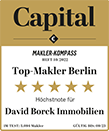Real Estate Neukölln
Ten years ago, Neukölln was still considered the poorhouse of Berlin. The news magazine Der Spiegel wrote about the quarter as the “Quarter on the Edge “, the call for help from the teachers of the Rütli school caused quite a stir. A lot has changed today, even if not all the problems have disappeared, of course. Where more than 150 nations live together, often under difficult social conditions, love, peace and harmony is not going to rule from one day to the next. But Neukölln is on its way.
The spirit of optimism can be felt best in the Reuter quarter around Weserstraße. For some years, driven out by the high rents in Mitte, Prenzlauer Berg and Friedrichshain, artists, designers, and other people engaged in culture have been drawn to “Kreuzkölln”, as the area on the border to Kreuzberg is affectionately called. Studios, galleries, hip bars, cosy cafés and small stores emerge everywhere. They add to the long-established blend of Turkish vegetable shops, corner pubs, Döner stalls and late-night shops and provide an interesting mix.
But things are also happening outside the Reuter quarter. By establishing cultural events and with modernizations and other measures, the heads of the district make continuous efforts to shake off the old image. With success! Year after year, the art and culture festival “48 Hours Neukölln” takes place, for instance. The “Neukölln Opera”, the “Home Port Neukölln” and the “Workshop of Cultures” draw interested people from all over Berlin to the district. The shutdown of the airport is also of benefit: the adjoining Tempelhofer Feld is now the largest open space in Berlin and an eldorado for sports and recreation.
Life is more placid in the southern part of the district. Single-family homes and smaller multi-family homes dominate in Buckow, Rudow and Britz. While the northern part of Britz is still urban, it is greener and quieter further south: the magnificent Britzer Garten alone, with its many flowerbeds, has a size of 90 hectares and owes its existence to the Bundesgartenschau (federal horticulture show) in 1985. Not far away, the Baroque Gutspark with its castle and manor invites people to promenade. Another interesting attraction is close by with the Hufeisensiedlung, which was built between 1925 and 1933. It is considered a groundbreaking urban facility of the modern era and was given the status of a World Cultural Heritage in 2008.
Another famous building can be found between Buckow and Rudow: the Gropiusstadt, a well known example for a post-war urban complex. It has evolved into its own quarter and is also home of Berlin’s largest shopping centre, the Gropius-Passagen. Parts of the former villages Buckow and Rudow on the other hand have remained true to their rural character. There are even still some farmsteads in Rudow. A 13th century church can be found in the centre of the two quarters.

 Back
Back 







